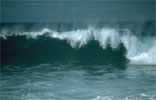 Guide to
Tsunamis
Guide to
Tsunamis
One of the worst natural calamities that can hit us is the Tsunami. Do you know what exactly makes a Tsunami happen? Or do you know what exactly Tsunami is?
A majority of us have a one line definition for Tsunami: it is a huge tidal wave. But that's wrong! Tsunamis have nothing to do with tidal waves. Tsunami is a reaction of what happens at the very bottom of the seabed. Bet you didn't know that! So, let's get to know more about Tsunami, shall we?
Tsunami is a Japanese word which needs to be broken up into two parts to get the exact English meaning. Basically, the first half of the word Tsunami, i.e. tsu, refers to harbor, whereas nami refers to waves. So, in the English language, the term Tsunami means harbor waves. Does that make sense to you? No, right? So you need to further understand what a Tsunami is and how does it happen.
There are three major causes of Tsunami: earthquakes, landslides and volcanoes. Now all these three disasters happen on land, but when it comes to Tsunamis, these happen at the very bottom of an ocean or sea. They are called underwater volcanoes, underwater earthquakes and underwater landslides.
Now let's study how exactly these three factors help in creating a Tsunami.
Earthquakes are the number one factors that cause Tsunamis to happen. Basically, when an earthquake occurs at the bottom of an ocean, it is because of the collision between the oceanic plates and continental plates. These plates form a huge part of the earth's crust, which release energy when they collide. Once this collision starts, the oceanic plate moves under the continental plate and a huge amount of energy that is equal to more than 10 atomic bombs is released. This energy causes an underwater earthquake, and because the oceanic plate moves, it makes the upper water surface move to. In short, there is a huge movement taking place underwater when an underwater earthquake happens.
Due to these movements, eventually a huge wave is formed, which travels through the ocean and gains strength gradually. Now, this wave keeps traveling in the ocean carrying that energy that was released, but as soon as it comes near a shore, it starts gaining height because its depth reduces. Slowly and gradually, it grows taller and taller and eventually hits the shore! This is how Tsunami happens.
There are a number of misconceptions related to Tsunamis, such as the 'fact' that they occur due to the heat of the sun or due to multiple waves combining together to form a big one. All those reasons are not true, and Tsunami has nothing to with the heat of the sun or multiple waves. It is a reaction on the upper surface of the ocean that is caused by the happenings underwater. In most cases, it has been witnessed that Tsunamis happen because of earthquakes, but they can also happen because of volcanoes and landslides under the sea. In fact, the whole process of earthquakes underwater includes landslides as well.
So, with this we learned how Tsunamis happen and what the actual cause behind them is.